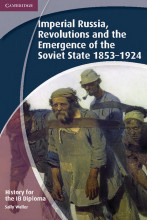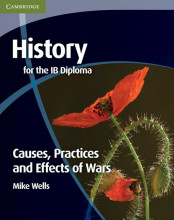Summary: History For The Ib Diploma: ... | 9781107684898 | Sally Waller
- This + 400k other summaries
- A unique study and practice tool
- Never study anything twice again
- Get the grades you hope for
- 100% sure, 100% understanding
Read the summary and the most important questions on History for the IB Diploma: Imperial Russia, Revolutions and the Emergence of the Soviet State 1853-1924 | 9781107684898 | Sally Waller
-
1 Conditions Alexander II inherited
-
1.1.1 Geographical weaknesses
-
What were the racial extremes inherited by Alexander II which could make creating a unified and strong Russia difficult?
- Less than 50% were Russian by birth
- Instead there was a melange of religions, races and languages; when Nationalism starts to take more of hold at the end of the 19th Century these are going to become more difficult to reconcile
- Examples of Russian diversity are: Lutheran Finns, Baltic Germans, Estonians and some Latvians, Roman Catholic Lithuansians, Poles, Ortohodoxs and other Belorussians and Ukrainians, Muslim peoples along southern border, Ortodoxn Greeks and Georgians, members of Armenians Apostolic church
-
1.1.3 Economic Weaknesses
-
What economic problems existed within Russian government prior to Alexander II?
- ever-widening dichotomy between state income and expenditure
- Eg. Russia's huge army and smaller navy absorbed around 45% of annual government spending
-
What export difficulties did Alexander II inherit?
Russia couldn't dominate European markets any longer with traditional exports of:- Grain
- Raw materials
-
In way did the Serf-based class structure not allow Russia industrialise as other European powers were doing?
90% of the population were Serfs; this meant that there wasn't 'Western' massive private investment into:- railways
- mills
- factories
- coal pits
- quarries
Because there was no bourgeoisie whose drive to better themselves and make a profit forced industrial change in Western European countries, Russia just stagnated because instead there was just total reliance on the free labour of the Serfs -
What are two examples of the effects of a Serf-based class structure not allowing for industrialisation in Russia?
1833: Russian total urban population only 2 million
Moreover, soviet historian P. A. Chroma estimated in 1830 in Russia:- 67,000 people worked in textile manufacture
- 20,000 in iron and steel industires
-
What was the level of industrialisation in Russia compared to other European powers?
1943: France had x10 as many mechanised spindles than Russia, and Britain had more than thirty times the number of mechanised spindles -
What is an example of the backwardness of Russian infrastructure before Alexander II?
Only 1851: First train ran between St. Petersburg and Moscow -
How much railway did Britain and Germany have the year before the first train ran between St. Petersburg and Moscow?
- Britain: 6.6 thousand stature miles
- Germany 3.6 stature miles
-
1.1.4 Tradition of autocracy
This is a preview. There are 4 more flashcards available for chapter 1.1.4
Show more cards here -
What was the position of Nicholas I as an autocrat (and the position inherited by Alexander II)?
- Tsar was 'divinely appointed'
- Tsar's title "emperor and autocrat of all Russia was associated with Ruthless authoritarianism
- Tsar's ukases (decrees) were law
-
What 'guiding principles' to the Tsarist system were introduced by Sergei Uvarov in 1833?
"Autocracy, Orthodoxy and Nationality'
These demanded that Russians should show unswerving loyality to:- Unlimited authority of the Tsar
- Russian Orthodox Church
- Russian nation
- Higher grades + faster learning
- Never study anything twice
- 100% sure, 100% understanding
Topics related to Summary: History For The Ib Diploma: ...
-
Conditions Alexander II inherited - Inherited Difficulties - Tradition of autocracy
-
Conditions Alexander II inherited - Specific Difficulties revealed by the Crimean War
-
Alexander II and the emancipation of the serfs 1855-81
-
The 1905 revolution and its aftermath - Causes of the 1905 Revolution
-
The 1905 revolution and its aftermath - Why did the Tsar survive the 1905 revolution?

































